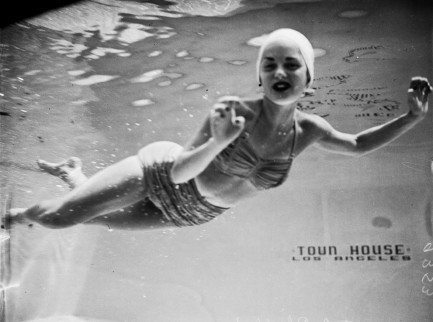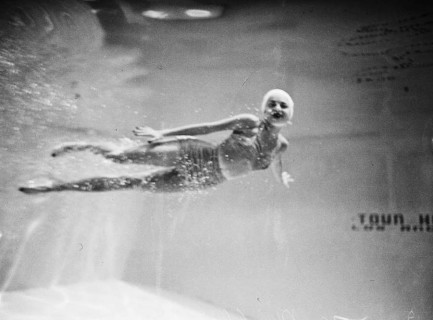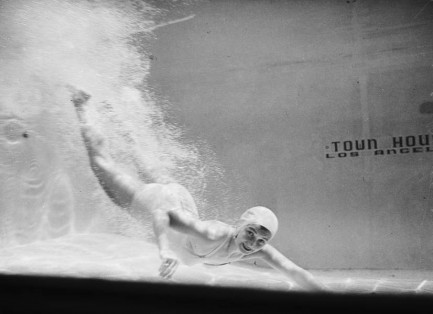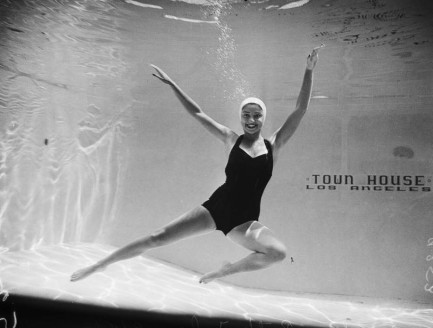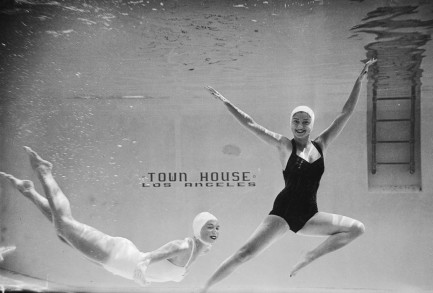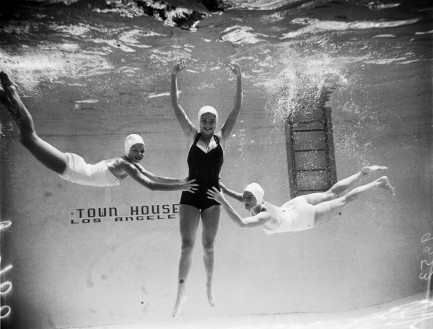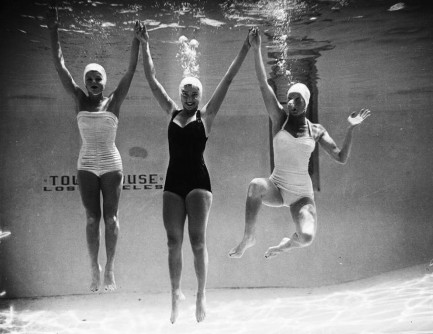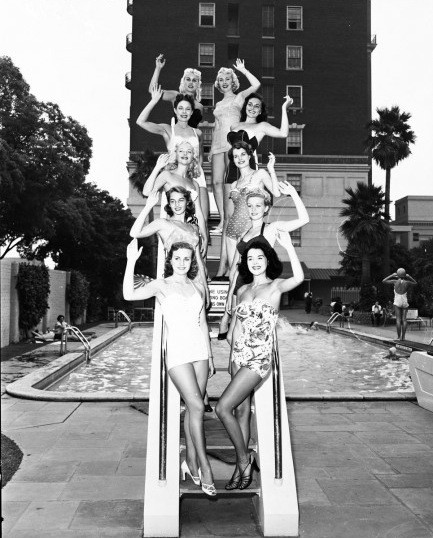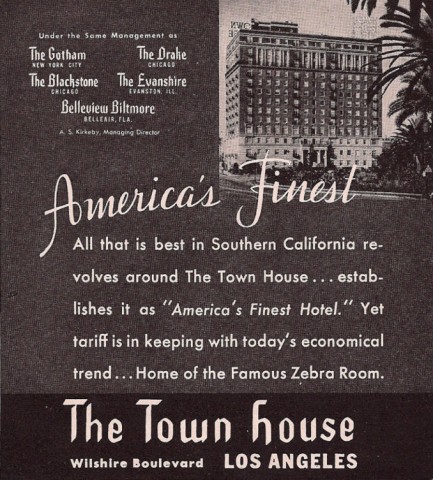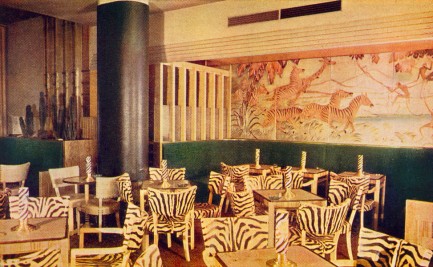 She barely stomached Hollywood. 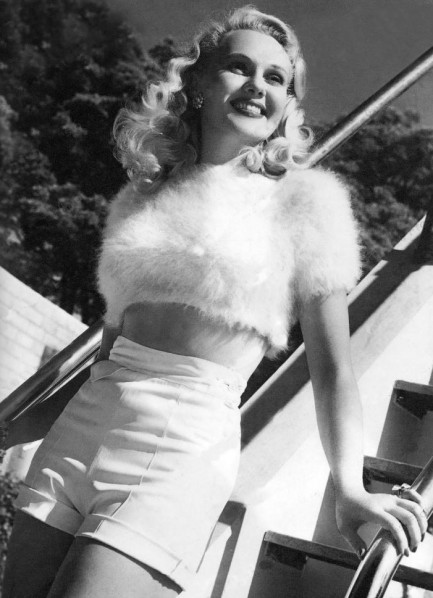 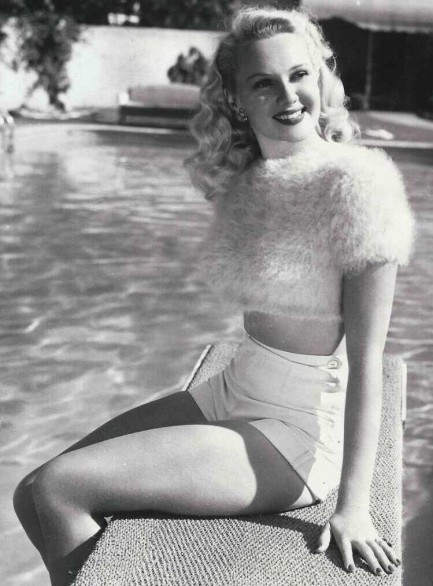
Adele Jergens, who appeared in I Love Trouble, The Corpse Came C.O.D., The Dark Path, and numerous other films, got her start in show business, like so many actresses of her era, when she won the a beauty contest—Miss World's Fairest, at the 1939 New York World's Fair. Later, as one of the famed Rockettes dancing troupe, she was named the number one showgirl in New York City. This led to her serving as understudy to burlesque dancer Gypsy Rose Lee in the Broadway production Star and Garter, and from there Jergens never looked back. That's probably why she forgot half of her sweater. These fun images of her with bare midriff were made in Los Angeles in 1946, by the pool at the famed Town House Hotel, a locale we've talked about more than once. Find out why by clicking its keywords below and scrolling through those posts, and you can do the same with Jergens if you want to see what else we've posted about her.
 Who says it never Raines in L.A? 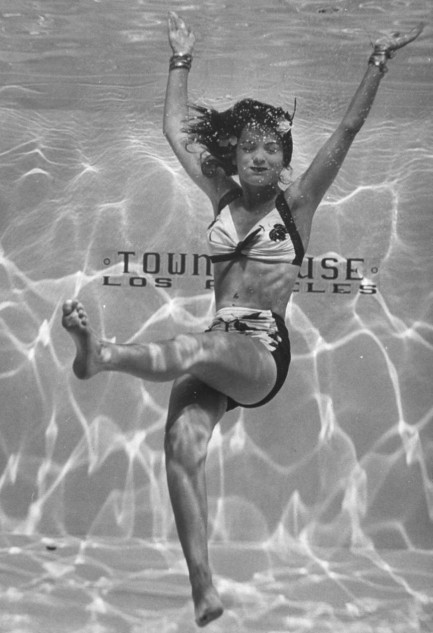
You can't tell with her face all scrunched up, but the person in the above photo is actress Ella Raines, who appeared in such films as Brute Force, The Web, and Phantom Lady. Here she makes a July 1943 cameo in the pool at the Town House Hotel in Los Angeles, which was famous for its water nymphs that frolicked as guests in the hotel bar watched through plate glass. We've featured the Town House pool before, and those shots are worth a look. Just click the keywords below and scroll.
 I always appreciate attention from a handsome lifeguard, but I think someone's drowning over there. 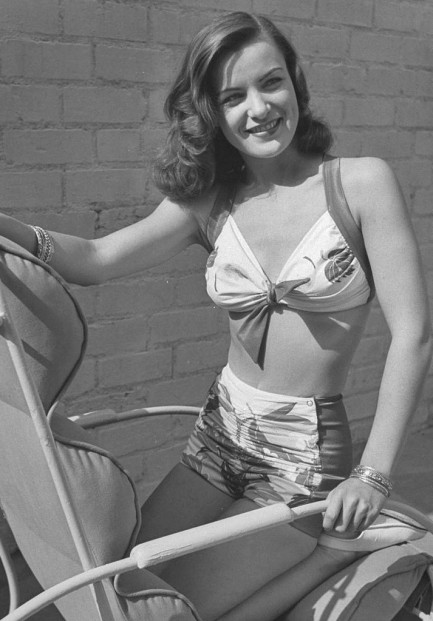
Above, U.S. born actress Ella Raines lounges in her bathing suit in this summery image from 1943 made in Los Angeles at the Town House Hotel. Later she'd take a dip in the pool. Raines appeared in such films as Phantom Lady, Impact, and Brute Force, before transitioning to television in the 1950s. We talked about her 1947 film noir The Web a few years ago and you can read about that here.
 Ice is nice, but harder than water. 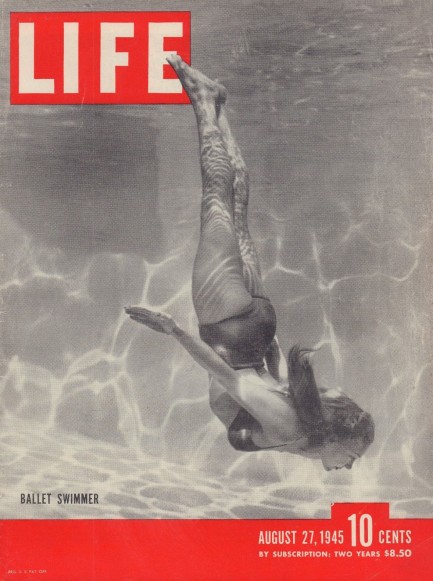
British skater and actress Belita, who was born Maria Belita Jepson-Turner, frolics in the pool at the Town House Hotel in Los Angeles for a cover of Life that hit newsstands today in 1945. We've shown you this pool before. A window from a swanky hotel bar known as the Zebra Room provided a view through one wall, which meant patrons could watch swimmers while enjoying cocktails. The hotel put together a group of women called Aqua Maidens who performed swim shows, but Belita was not a Maiden. She was already famous for skating in the 1936 Olympics (though she had finished only sixteenth), and had established a Hollywood career with 1943's Silver Skates and 1944's Lady, Let's Dance. She would also make 1946's Suspense, which was unique for combining skating with film noir.
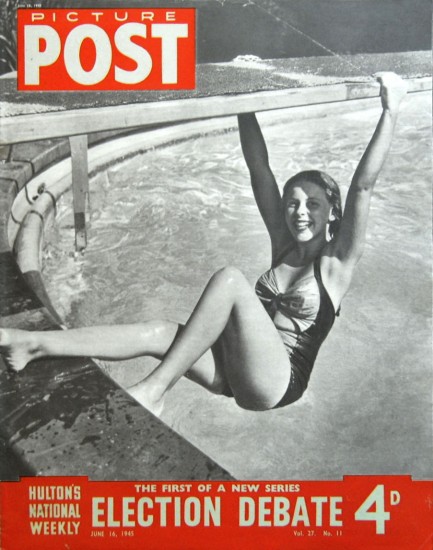 In addition to being an ace skater Belita was an accomplished dancer, and the Life photos show her demonstrating her underwater ballet skills. She even wears a tutu in a couple of shots. Interestingly, Picture Post, a British Life-like magazine that was considered imitative, had already featured Belita on its cover, also at the Town House, two months earlier on June 16, 1945. Doubtless both sets of photos were from them same session. So in this case Life was the imitator. In addition to being an ace skater Belita was an accomplished dancer, and the Life photos show her demonstrating her underwater ballet skills. She even wears a tutu in a couple of shots. Interestingly, Picture Post, a British Life-like magazine that was considered imitative, had already featured Belita on its cover, also at the Town House, two months earlier on June 16, 1945. Doubtless both sets of photos were from them same session. So in this case Life was the imitator. Belita wasn't the most famous ice skater in Hollywood during the 1940s—Sonja Henie was a huge star, and Vera Ralston was probably better known as well. That may be one reason why Belita managed only eight or nine films before moving on to other pursuits. She eventually retired to the village of Montpeyroux, France, where she died in 2005 at age eighty-two. But the photos below are eternal. 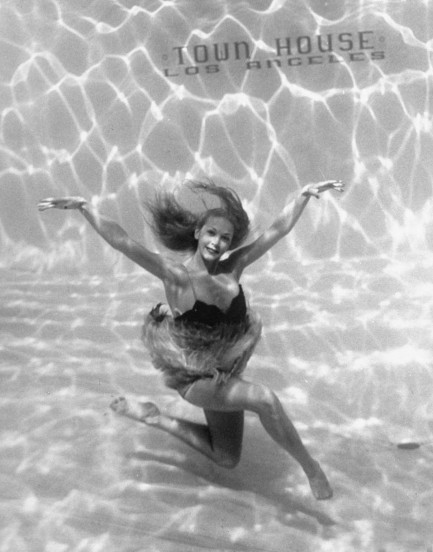 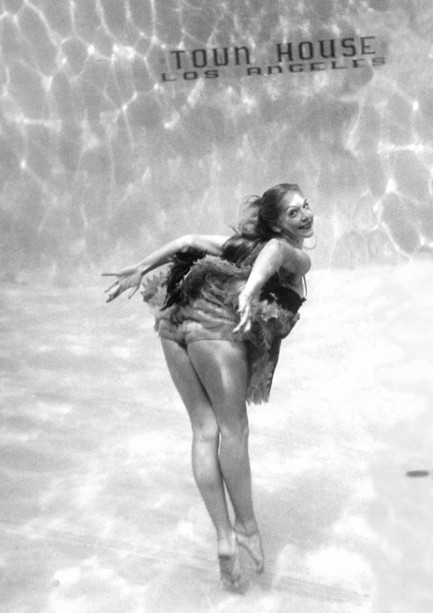 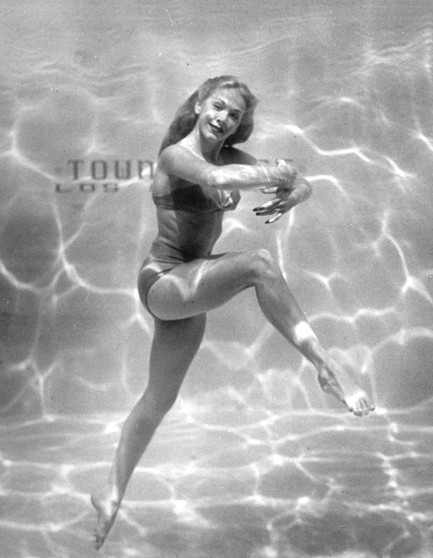 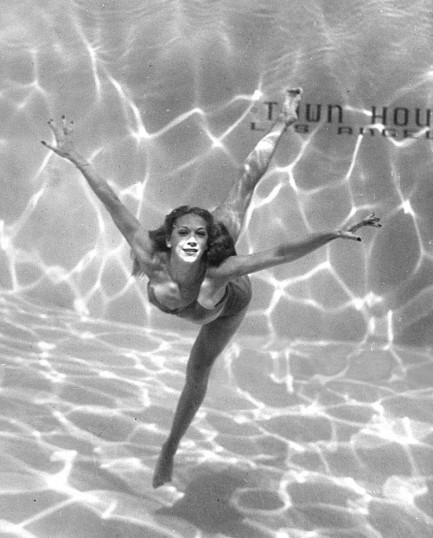 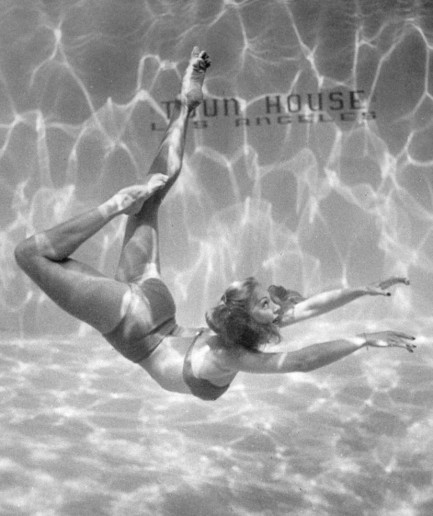 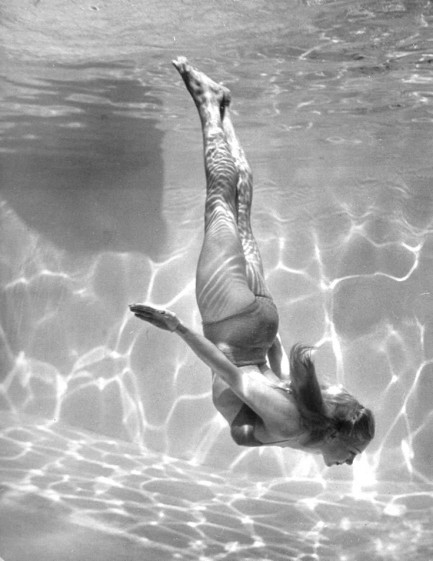
|
 |

The headlines that mattered yesteryear.
2003—Hope Dies
Film legend Bob Hope dies of pneumonia two months after celebrating his 100th birthday. 1945—Churchill Given the Sack
In spite of admiring Winston Churchill as a great wartime leader, Britons elect
Clement Attlee the nation's new prime minister in a sweeping victory for the Labour Party over the Conservatives. 1952—Evita Peron Dies
Eva Duarte de Peron, aka Evita, wife of the president of the Argentine Republic, dies from cancer at age 33. Evita had brought the working classes into a position of political power never witnessed before, but was hated by the nation's powerful military class. She is lain to rest in Milan, Italy in a secret grave under a nun's name, but is eventually returned to Argentina for reburial beside her husband in 1974. 1943—Mussolini Calls It Quits
Italian dictator Benito Mussolini steps down as head of the armed forces and the government. It soon becomes clear that Il Duce did not relinquish power voluntarily, but was forced to resign after former Fascist colleagues turned against him. He is later installed by Germany as leader of the Italian Social Republic in the north of the country, but is killed by partisans in 1945.
|

|
|

It's easy. We have an uploader that makes it a snap. Use it to submit your art, text, header, and subhead. Your post can be funny, serious, or anything in between, as long as it's vintage pulp. You'll get a byline and experience the fleeting pride of free authorship. We'll edit your post for typos, but the rest is up to you. Click here to give us your best shot.

|
|









 In addition to being an ace skater Belita was an accomplished dancer, and the Life photos show her demonstrating her underwater ballet skills. She even wears a tutu in a couple of shots. Interestingly, Picture Post, a British Life-like magazine that was considered imitative, had already featured Belita on its cover, also at the Town House, two months earlier on June 16, 1945. Doubtless both sets of photos were from them same session. So in this case Life was the imitator.
In addition to being an ace skater Belita was an accomplished dancer, and the Life photos show her demonstrating her underwater ballet skills. She even wears a tutu in a couple of shots. Interestingly, Picture Post, a British Life-like magazine that was considered imitative, had already featured Belita on its cover, also at the Town House, two months earlier on June 16, 1945. Doubtless both sets of photos were from them same session. So in this case Life was the imitator.






